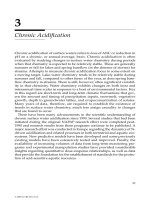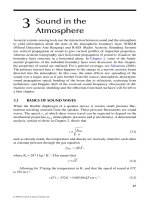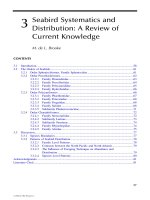Cost accounting chapter 3
Bạn đang xem bản rút gọn của tài liệu. Xem và tải ngay bản đầy đủ của tài liệu tại đây (66.97 KB, 18 trang )
Chapter 4: Activity-based costing
Broad averaging and its consequences
Undercosting: a product consumes a high level of
resources but is reported to have a low cost per unit
Overcosting: a product consumes a low level of
resources but is reported to have a high cost per unit
Product-cost cross-subsidisation: if a company
undercosts one product then it overcosts at least one
other product. A cost is uniformly spread across
products without a recognition of which products
require what resources in what amounts.
Simple costing system
(single indirect-cost pool)
Identify the products that are the chosen cost objects
Identify the direct costs of the products
Select the cost-allocation bases to use for allocating
indirect costs to the products
Identify the indirect costs associated with each cost-
allocation base
Compute the rate per unit of each cost-allocation base
used to allocate indirect costs to the products
Compute the indirect costs allocated to the products
Compute the total costs of the products
Refining a costing system
A refined costing system reduces the use of
broad averages for assigning the cost of
resources to cost objects and provides better
measurement of the costs of indirect
resources used by different cost objects
Causes of a refined costing system
Increase in product diversity
Increase in indirect costs
Advances in information technology
Competition in product markets
Activity based costing (ABC) refines a
costing system by identifying individual
activities as the fundamental cost objects.
An activity is an event, task, or unit of work
with a specific purpose – e.g. designing
products, setting up machines, operating
machines, distributing products.
Fundamental
cost objects
Assignment of
other cost
objects
activities Costs of
activities
Cost of
products,
services,
customers
Direct-cost tracing: ABC system reclassifies some
indirect costs as direct costs by evaluating if some
currently indirect costs can be traced to cost objects
Indirect-cost pools: ABC system create smaller
indirect cost pools linked to the different activities
Cost allocation bases: for each activity cost pool, a
measure of the activity performed served as the
cost-allocation base.
Cost hierarchies
A cost hierarchies categories indirect cost into
different cost pools on the basis of the different types
of cost drivers, or cost allocation bases or different
degrees of difficulty in determining cause and effect
relationship. ABC commonly uses a cost hierarchies
with 4 levels:
Output unit-level cost
Batch level costs
Product sustaining costs
Facility sustaining costs
Output unit-level cost: the costs of activities
performed on each individual unit of a product or
service
Batch level costs: the costs of activities related to a
group of units or products or services rather than to
each individual unit of product or service
Product sustaining costs: the costs of activities to
support individual products regardless of the No. of
units or batches
Facility sustaining costs: the costs of activities that
cannot be traced to individual products but that
support the organisation as a whole
Implementing ABC
Identify the products that are the chosen cost objects
Identify the direct costs of the products
Select the cost allocation bases to use for allocating indirect
costs to the products
Identify the indirect costs associated with each cost allocation
base
Compute the rate per unit of each cost allocation base used to
allocate indirect costs to the products
Compute the indirect costs allocated to the products
Compute the total cost of the products by adding all direct and
indirect costs assigned to the products
Using ABC for improving cost
management and profitability
Activity based management is a method of
management decision making that uses
activity based costing information to improve
customer satisfaction and profitability
ABM includes decisions about pricing and
product mix, reduction of costs, improvement
of processes, and product design.
Pricing and product mix decisions: ABC
system gives managers cost information that
helps on making and selling diverse products
Cost reduction and process improvement
decisions: ABC systems helps identify where
and how to reduce costs
Design decisions: management can evaluate how its
current product and process designs affect activities
and costs as a way of identifying new designs to
reduce costs
Planning and managing activities: companies specify
budgeted costs for activities and use budgeted cost
rates to cost products using normal costing. At year
end, budgeted and actual costs are compared to see
how well activities were managed
ABC and department costing systems
Many companies use separate indirect cost
rates for each department or each
subdepartment
Implementing ABC systems
Significant amount of indirect costs are allocated using
one or two cost pools
All or most indirect costs are identified as output unit-
level costs (few indirect costs as batch-level costs,
product/facility-sustaining costs)
Products make diverse demands on resources because
of differences in volume, process steps
Products that a company is well suited to make show a
small profits, products that a company is less suited to
produce show large profits
Operations and accounting staff have significant
disagreement about the costs of manufacturing and
marketing products or services
ABC in service and merchandising
companies
ABC has many applications in service and
merchandising companies
Costs are divided into homogenous cost pools and
classified as output unit level costs, batch level
costs, product sustaining costs, or facility sustaining
costs
The cost pools correspond to activities
Costs are allocated to products/customers using cost
allocation bases that have a cause-and effect
relationship with the costs in the cost pool
In a bank, ABC applications: calculate cost of
performing ATM transactions, opening and closing
accounts, administering mortgage, processing Visa
transactions. Help identify profitable products and
customer segments
ABC in service: postal service: calculate cost of
delivering mails. Delivering to remote locations is far
greater than delivering within urban areas. ABC
helps manage and reduce costs.









